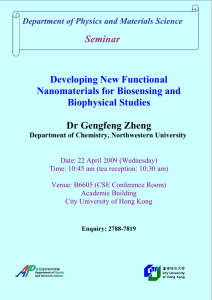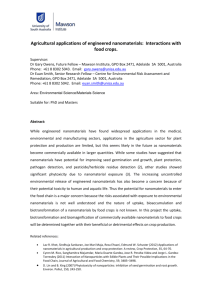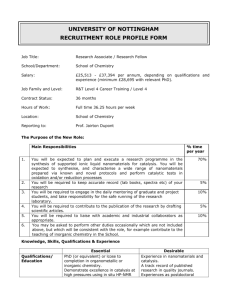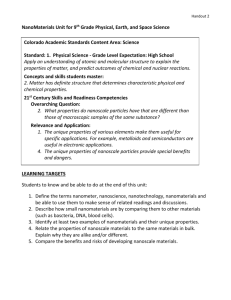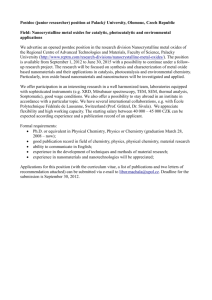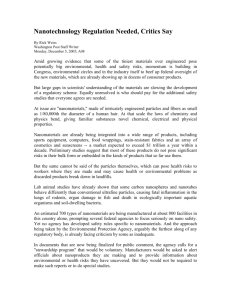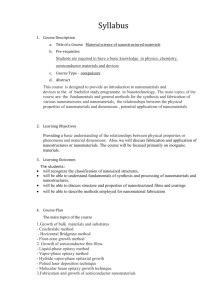Nanomaterials • Colloids • Clusters • Nanoparticles
advertisement
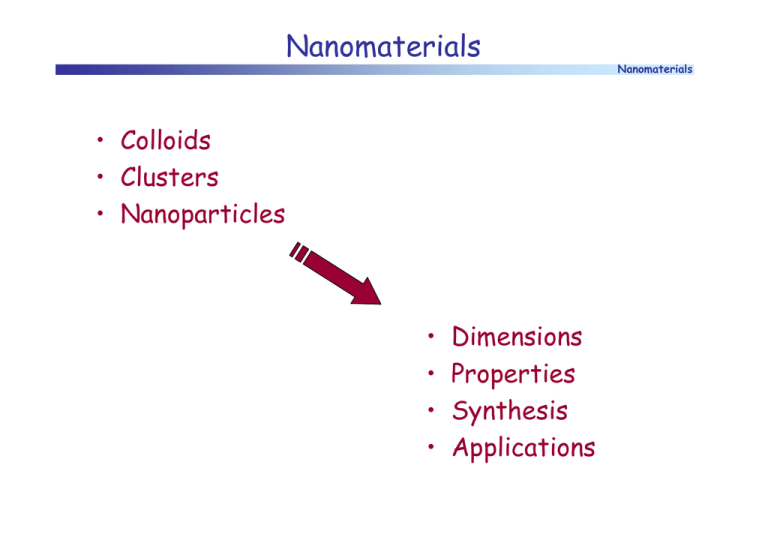
Nanomaterials • Colloids • Clusters • Nanoparticles • • • • Dimensions Properties Synthesis Applications Nanomaterials Physical-chemical properties Nanomaterials Cluster classification • • • • • • Metal: Pt, Fe… Covalent: C, Si… Ionic: CaI2 Hydrogen bonding: HF Molecule: As4 Van-der-Waals: He, H2 Nanomaterials Metallic bond • Electron delocalization Nanomaterials Band model Nanomaterials • Energy levels Isolator Semi-conductor Conductor conduction band conduction band conduction band Band gap valence band valence band valence band Semi-conductors Nanomaterials Semi-conductor Conduction band Valence band N-dotation Conduction band donator Valence band P-dotation Conduction band acceptor Valence band Band theory of metals • • Nanomaterials Changing electron levels changed optical, electronic and catalytic properties Properties different from the bulk metal and molecular structures N=2 N=3 N = 1 mol N=4 Atom Cluster Colloid Bulk metal Band gap Changing metallic properties Nanomaterials Band Affiliation Photoelectronspectra of Hg-: 6s 6p affiliation Nanomaterials Quantum size effect Nanomaterials • Change of the electronic properties • De Broglie wavelength: the freely mobile electrons are very limited in the reduced dimension “Size Induced Metal-Insulator Transition” Semiconductor • Band gap controllable Nanomaterials Ionization Potentials and Electron Affinities Nanomaterials IP: Xn → Xn+ + e- EA: Xn + e- → Xn- The bigger radius the less energy is necessary to remove an electron EA is decreasing with the radius (less surface for a small cluster) ∼ Electron delocalization Ionization Potentials for Na and K Nanomaterials Hydrogen Storage Low IP: • H2 dissociates • Hydrid formation Nanomaterials High IP: • Molecular chemisorption • Hydrogen storage!!! Transition from molecular to dissociative chemisorption What are nanoparticles? • • • • • Nanomaterials NANO (Greek) = dwarf 1 nanometer = 1 nm = 10 -9 m = 0.000000001 m – Some 1000 atoms or molecules – Cluster ≤ 1000 Research: transition of properties from solid state to atoms – Different chemical and physical properties: • Electric conductivity • Chemical reactivity • Optical properties Quantum mechanic rules and not longer classical physics due to their small size Application in catalysis and nanoelectronics What are colloids? • "Colloid" (Greek: Kolla = glue) 1861 Thomas Graham • Colloidal Systems: homogeneous medium and a dispersed material • “Mesoscopic " dimension: between solid state properties and molecular effects • Large specific surface • New properties by functionalization and configuration Nanomaterials Nanochemistry • For example: Nano-droplet Drop of liquid water with 50 H2O molecules Diameter = 1 nm molecules Nanomaterials Snowflake: 1 mm Nanomaterials Nanomaterials From atoms to solids Nanometer-Scale A short reminder: 1 nanometer = 1 nm = 10 -9 Nanomaterials m = 0.000000001 m Cluster, Colloids, Nanoparticles Polymers Molecules DNS, virus Atoms 00 Solids Proteins 102 104 106 1 nm 10 nm 1000 m2 Molecular chemistry and physics 108 1010 mass 100 nm 100 m2 big molecules 1012 1µm 10 m2 small Cluster and Colloid chemistry solids diameter surface Solid state chemistry and physics Rare gas clusters • Magic numbers of rare gas clusters in MS: – 13 – 55 – 147 – 309 – 561 • Geometric shell: Mackey Icosahedron – 5-fold symmetry axis (fcc) Nanomaterials Special Nanotypes: Fullerenes Nanomaterials • a large current between two nearby graphite electrodes in an inert atmosphere • the resulting carbon plasma arc between the electrodes cools into sooty residue from which many fullerenes can be isolated Special Nanotypes: Nanotubes • • • • simple carbon C ! Diamond: four next neighbors → very stable plane and form a honeycomb lattice planes are stacked up, to form a solid body Nanomaterials Simple metal cluster • Magic number for neutral atoms (soft metals): – 8 – 20 – 40 – 58 Nanomaterials Electronic Effects Nanomaterials Geometric effects Nanomaterials Cuboctahedron • 6 squares and 8 triangles • 12 corners and 24 edges • Geometric shells – Cubic (ccp) or hexagonal (hcp) closed packed A B C A A B C A Coordination number = 12 Magic Numbers Nanomaterials • Magic number of atoms N N = 10 n2 + 2 (n = number of shells) Nedge= 2 nN- 1-shell 13 atoms Nedge= 3 Nedge= 4 Nedge= 5 2-shell 55 atoms 3-shell 147 atoms 4-shell 309 atoms van Hardeveld, Hartog, Suface Science, 15, 1969, 189-230. • 8 hexagons and 6 squares • 36 edges and 24 corners Apparent diameters (dN) of particles Nanomaterials • • • • surface ruthenium atoms (Ns) total ruthenium atoms (Nt) density (rN) molecular weight (MN) dN = (3*MN*Ntotal)/(4*π*Nav*rN)1/3 (Nav is the Avogadro number) Nt = 16 Nedge3 – 33 Nedge2 + 24 Nedge – 6 1.0 Ns = 30 Nedge2 – 60 Nedge + 32 Diameter = 1.105 datomic* Ntotal1/3 datomic = 0.27 nm Dispersion Dispersion = Nsurface/Ntotal 0.8 0.6 0.4 0.2 0.0 0.0 2.0 4.0 Diam ère apparent Diameter 6.0 8.0 Ratio surface/total atoms Nanomaterials Numbers for Ns, Nt and the resulting diameter dN for varying Nedge Nedge 2 3 4 5 6 7 8 Nt 38 201 586 1289 2406 4033 6266 Ns 32 122 272 482 752 1082 1472 dN 1.0 1.75 2.49 3.24 3.99 4.74 5.50 7000 6000 5000 4000 Number of atoms 3000 2000 1000 A total A surface 0 1 2 3 4 N edge 5 6 7 EPS: Shell observation Nanomaterials Application of nanomaterials Nanomaterials Engineered particles • • • • • • Catalysts for cars: Pt, Pd Pastes, glues Concrete Semi-conductor Photoconductor Microelectronic • Nano-paints • Pharmaceuticals • Quantum dots • Ceramics • Cosmetics • Performance chemicals Preparation of Nanomaterials • • • • • Nanomaterials Lithography Sol-Gel-process Flame assisted deposition Gas phase deposition (CVD, PVD) Chemical preparation in solution e.g. reduction of different metal complexes by BH or H2 in solution • Self-assembled monolayers (SAM) • Precipitation Defined and narrow size distribution Best results: Synthesis in solution and self assembly Lithography Nanomaterials Principle • based on the repulsion of oil and water • image is placed on the surface with an oil-based medium • acid 'burns' the oil into the surface • water remains on the non-oily surface and avoids the oily parts • a roller applies an oil-based ink that adheres only to the oily portion of the surface Lithography Modern technique • A fused silica surface, covered with a release layer, is pressed into a thin layer of a silicon-containing monomer • Illumination by a UV lamp polymerizes the surface into a hard material • Upon separation of the fused silica template, the circuit pattern is left on the surface • A residual layer of polymer between features is eliminated by an etch process • Template fabrication process limits the resolution of the features (20 nm) Nanomaterials Sol-gel process Nanomaterials • Formation of a colloidal suspension (sol) and gelation to form a network in a continuous liquid phase (gel) • precursors for these colloids consist of a metal or metalloid element surrounded by various reactive ligands Metal alkoxides: alkoxysilanes, such as tetramethoxysilane (TMOS) and tetraethoxysilane (TEOS). • three reactions: hydrolysis, alcohol and water condensation Lev, O. et al. Analytical Chemistry. 1995, 67(1), 22A-30A. K.D. Keefer, in: Silicon Based Polymer Science: A Comprehensive Resource; eds. J.M. Zeigler and F.W.G. Fearon, ACS Advances in Chemistry Ser. No. 224, (American Chemical Society: Washington, DC, 1990) pp. 227-240. Sol-gel polymerization: three stages Nanomaterials • 1. Polymerization of monomers to form particles 2. Growth of particles 3. Linking of particles into chains, then networks many factors affect the resulting silica network: – pH – catalyst nature and concentration – temperature – H2O/Si molar ratio – time of reaction – aging temperature and time – reagent concentrations The sol-gel process Nanomaterials Sol-gel technologies Nanomaterials Chemical methods Nanomaterials Top-down and bottom-up methods • bulk material is reduced using physical tools. • nanostructures from molecular structures via chemical reactions. The bottom-up method provides better results for the synthesis of nanomaterials with good reproducibility and yields Top-down Bottom-up Growth and Electrostatic stabilization of nanoparticles Nanomaterials • Homogeneous and heterogeneous nucleation + • Control of the dispersion Nanoparticles Repulsion Attractive forces (van der Waals) Synthesis of colloids • • • • • Nanomaterials Radiation induced synthesis of colloids Electrochemical synthesis of colloids Ultrasound-assisted electrochemical synthesis Salt reduction Organo-metallic synthesis (thermal decomposition, ligand reduction or ligand displacement) Synthesis of colloidal solutions of metal nanoparticles Nanomaterials Organometallic Precursors Nanomaterials • Ruthenium-1,5-cyclooctadiene-1,3,5-cyclooctatriene – Ru(COD)(COT) 2 Ru Cl3+ 6 + 3 Zn MeOH Ru + 3 ZnCl2 + 2 C8H14 2 90 °C, 3 h • Bis(dibenzylideneacetone)platinum(0) O – Pt(dba)2 CH CH C CH CH O K2PtCl4 CH CH CH3COONa EtOH (90 °C, 2 h) CH CH Pt0 CH CH CH CH O Pt(dba)2 or Pt2(dba) 3 Preparation by organo-metallic chemistry Nanomaterials Precipitation • Decomposition of organometallic precursors • Precipitation – Control of the process – Monodisperse nanoparticles Nanomaterials Stabilization • Stabilisation by amplification of the repulsive forces • Sterical stabilisation by ligands or polymers a) b) Nanomaterials Ligand-Stabilized Cluster • Controlled chemical synthesis of well-defined Gold-, Palladium-, Platinum-, Ruthenium or Rhodium cluster • Bimetallic cluster: – Gold and Rhodium – Palladium and Gold • A ligand layer is indispensable for their stabilization and application G. Schmid et al. Nanomaterials Monolayers Nanomaterials • single, closely packed layer of atoms or molecules • Langmuir monolayer one-molecule thick insoluble layer of an organic material spread onto an aqueous subphase • compounds used to prepare are amphiphilic materials that possess a hydrophilic headgroup and a hydrophobic tail a) fatty acid b) methyl ester c)-e) phospholipids f) schematic sketch Langmuir-Blodgett film • • • • • • • Nanomaterials Irving Langmuir and Katherine Blodgett (1900) transfer of monolayers from liquid to solid substrates deposition of multi-layer films on solid substrates structure of the film can be controlled at the molecular level films exhibit various electrochemical and photochemical properties LB-film memory chip: data bit is represented by a single molecule complex switching networks Self-organization Nanomaterials • generates structural organization on all scales from molecules to galaxies • reversible processes: disordered components form structures of patterns • static self-assembly: system is in equilibrium and does not dissipate energy • dynamic self-assembly is when the ordered state requires dissipation of energy. • Examples: – weather patterns – solar systems – self-assembled monolayers Self-assembled monolayers Nanomaterials • surfaces consisting of a single layer of molecules on a substrate • monolayers can be prepared simply by adding a solution of the desired molecule onto the substrate surface and washing off the excess • Example: alkane thiol on gold – Sulfur has particular affinity for gold and an alkane with a thiol head group will stick to the gold surface with the alkane tail pointing away from the substrate. G. Schmid, M. Bäumle, N. Beyer, Angew. Chem., 2000, 112, 187-189; Angew. Chem. Inter. Ed. Engl., 2000, 39, 181."Geordnete zweidimensionel Monolagen von Au55-Clustern" Self organized Growth of Quantum Dots • Self organization occurs during the layer growth Nanomaterials Molecular Printing Nanomaterials • Synthesis of a networked polymer in presence of a template molecule • Template molecule controls by its defined geometry the growth, structure and arrangement of the system • Functional groups of the monomer are fixed on the template and copy the form of the template • Extraction of the template • Defined cavities with layout • Selection of the host molecule works by molecular identification and can be fixed Physical Vapor Deposition (PVD) Nanomaterials • • • Deposition of thin films of various materials onto various surfaces (e.g. semiconductor wafers) by physical means Application: – semiconductor devices, – aluminized mylar for balloons and snack bags – coated cutting tools for metalworking. Variants of PVD include: – Evaporative deposition – Sputtering – Pulsed laser deposition Chemical Vapor Deposition (CVD) • • • • • Nanomaterials Chemical process for depositing thin films of various materials The substrate is exposed to one or more volatile precursors, which react and/or decompose on the surface to produce the desired deposit Volatile byproducts are removed by gas flow through the reaction chamber The CVD process is also used to produce synthetic diamonds Application in semiconductor industry to deposit various films including: – Polycrystalline and amorphous silicon, – SiO2, – silicon germanium, y – tungsten, silicon nitride, erg n E – silicon oxynitride, – titanium nitride Chemical reaction CVD-Fundamental reaction steps Nanomaterials • • • • Vaporization and Transport of Precursor Molecules into Reactor Diffusion of Precursor Molecules to Surface Adsorption of Precursor Molecules to Surface Decomposition of Precursor Molecules on Surface and Incorporation into Solid Films • Recombination of Molecular Byproducts and Desorption into Gas Phase Precursor Solid material Substrate (Disadvantage: often with poor control over the thickness of the molecular layer) Pulsed Arc Cluster Ion Source Generation of cluster: • Vaporization of the bulk material • Condensation in carrier gas • Mass separation Nanomaterials Flame assisted deposition • Decomposition of precursors in a flame (1200 - 2200 °C) • Ar/H2 • Particle size depending on – Temperature – Precursor – Reaction time Nanomaterials Transmission Electron Microscopy • • • • • Cd/Se nanoparticles Organic ligand shell shows low contrast Structure Morphology Size Nanomaterials TEM Analysis Nanomaterials The size of the particles were determined by observation of more than 200 particles from a TEM picture. Number of particles Adobe Illustrator120 TEM mm nm x y Origin 110 100 90 80 70 60 50 40 30 20 10 0 1,4 1,6 1,8 2,0 2,2 2,4 2,6 2,8 3,0 3,2 3,4 3,6 3,8 mean size: 2.3 + 0.9 nm Size / nm AFM Analysis Nanomaterials • Individual particles can be visualized: – length – Width – Height – Morphology – Surface texture • Can distinguish between different materials • Provide spatial distribution on material topographies Scanning Tunneling Microscopy Nanomaterials • Tunneling of electrons Oxygen on Ru Future Nanomaterials 1st generation: passive nanostructures: coatings, nanoparticles, nanostructured, materials, ceramics 2nd generation: active nanostructures: gas sensors, medicine, 3rd generation: 3D-nanosystems with assembling techniques (2010) Thank you for your attention Question Nanomaterials ?

